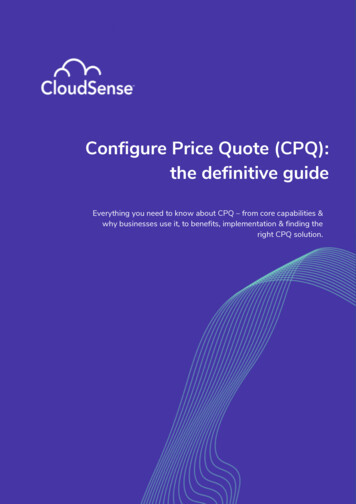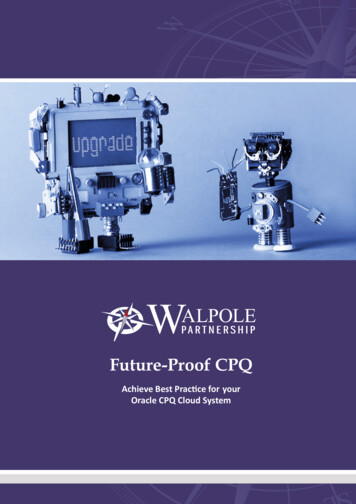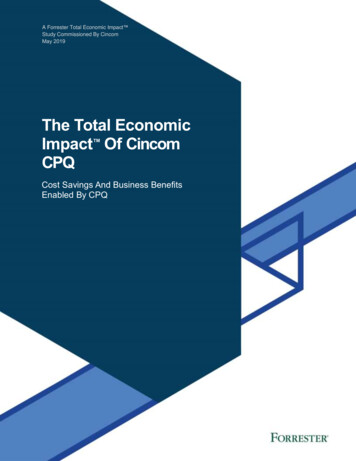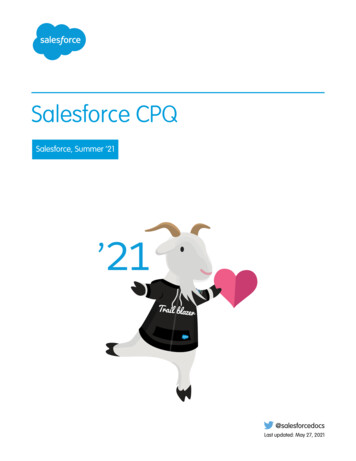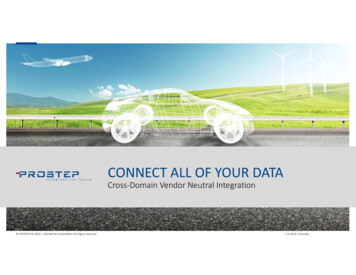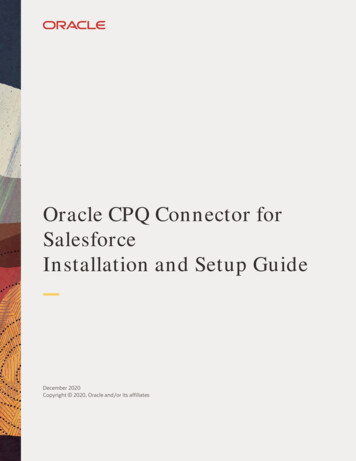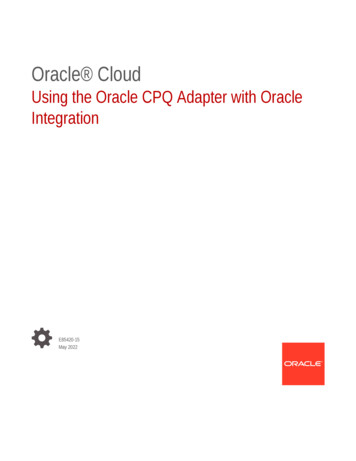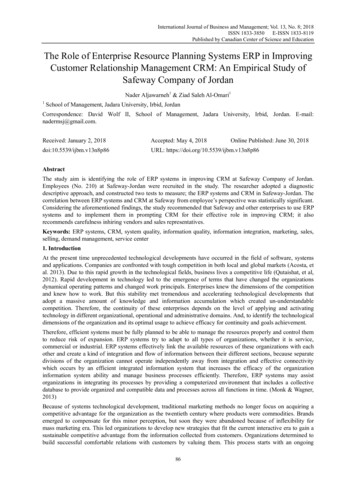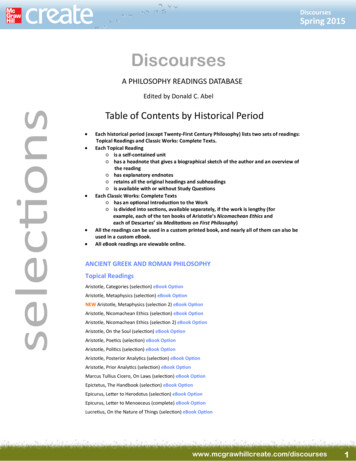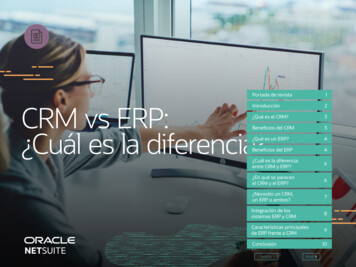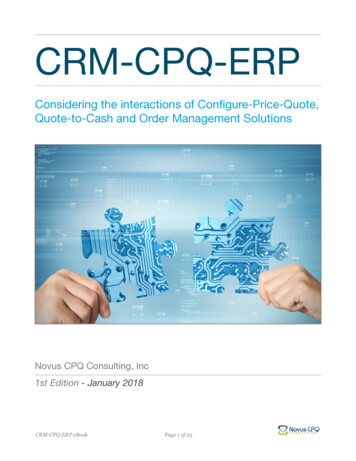
Transcription
CRM-CPQ-ERPConsidering the interactions of Configure-Price-Quote,Quote-to-Cash and Order Management SolutionsNovus CPQ Consulting, Inc1st Edition - January 2018CRM-CPQ-ERP eBookPage 1! of 25!!
Considering the interactions of CPQ, QTC and Order Management Solutions3Getting Started .3Chapter 1 - Overview of CPQ, Quote-to-Cash and Order Management / ERPSolutions .4What does “Front Office” mean?.4What does “Back Office” mean? .4CPQ Solutions . 5Quote to Cash Solutions . 6Order Management/ERP . 6Chapter 2 - IT Considerations when designing an end-to-end QTC Solution .9Business Logic .9Business Data .9What CRM Platform do you (want to) use? .10How are you planning to sell your Products & Services? . 11Do you need Contract Lifecycle Management (CLM)? .12Do you have an existing Back Office Order Management System? . 12Summary .13Chapter 3 - Segmenting Solutions that improve the Quote-to-Cash Process 14(1) Leveraging ERP for a Quote to Cash Solution . 14(2) Level of Industry Specialization .15(3) Required Complexity .16(4) Breadth of Solution: CPQ vs. QTC .17(5) B2B vs. B2C .18Chapter 4 - Successfully selecting your Front Office (CPQ/QTC) Solution .19Route-to-Market Considerations: Sales & Channel Partners .20Route-to-Market Considerations: eCommerce .20Chapter 5 - Conclusions for improving the Quote-to-Cash Process .23(1) Identify your business needs .23(2) Consider your existing IT landscape .23(3) Start identifying potential Front Office Solutions .24CRM-CPQ-ERP eBookPage 2! of 25!!
Considering the interactions of CPQ,QTC and Order Management SolutionsGetting StartedAs Configure-Price-Quote (CPQ) Vendors provide more capabilities that go beyond thetraditional confines of CPQ it makes sense to take a closer look at the processes andcapabilities covered by CPQ, Quote-to-Cash (QTC) and Order Management/EnterpriseResource Planning (ERP) Solutions. The objective is to help businesses to determine anideal alignment of functionality and systems for their businesses.Here is an overview of what will be covered in this e-book:1. Overview of CPQ, Quote-to-Cash and Order Management / ERP Solutions2. IT Considerations when designing an end-to-end QTC Solution3. Segmenting Solutions that improve the Quote-to-Cash Process4. Successfully selecting your Front Office (CPQ/QTC) Solution5. Conclusions for improving the Quote-to-Cash ProcessCRM-CPQ-ERP eBookPage !3 of !25!
- Overview of CPQ, Quote-toCash and Order Management / ERPSolutionsChapter 1Let us start by clarifying the difference between Front Office and Back Office Systems.What does “Front Office” mean?Front Office applications are primarily designed to automate most or all customer-orientedbusiness processes. Generally, Front Office applications are part of customer relationshipmanagement (CRM), and provide an interface for the end user or customer to request someavailable service. Front Office applications may provide services, such as quoting a newproduct, ordering a new product, order status, usage tracking for metered services and livecustomer support. A front office application, in many cases, is interconnected with the backoffice enterprise resource planning (ERP) or related applications, which provide real-timedata about product inventory and records of each transaction processes on the Front OfficeNote: CPQ and Quote-to-Cash Solutions are typically part of “Front Office” SolutionsWhat does “Back Office” mean?A Back Office application comprises the software that an organization uses to administeroperations that are not related to any direct sales effort (such as manufacturing a product)and interfaces that are not seen by consumersNote: Order Management / ERP Solutionsare part of “Back Office” SystemsHere an overview of the Process Steps involvedCRM-CPQ-ERP eBookPage !4 of !25!
Note that these Process Steps are typically processed in different IT Systems (CRM, CPQ,QTC and ERP).While the definitions and the Process Step Overview are a good starting point we need tolook deeper into the different capabilities of CPQ, Quote to Cash and Order Management /ERP Solutions to understand what are unique capabilities of each Solution and where thereis functional overlap.CPQ Solutionsare part of the Front Office and help Sales Teams, Channel Sales Teams and in some casesEnd-Customers (via an eCommerce website) to do the following Find and Configure (complex) products Find the correct price for any customer Get all required approvals before a quote is issued Prepare a quote and send it to the customer Analyze DataNote: CPQ Solutions require Master Data (e.g. Customer, Material, Pricing) andConfiguration Rules (e.g. Sales & Marketing Rules, Engineering Rules) that are used toConfigure, Price and Quote a Company’s Products and Services. If the Solution offerseCommerce capabilities it must be possible to order and Invoice the configured productsand/or services.CRM-CPQ-ERP eBookPage !5 of !25!
Quote to Cash Solutionsare also a part of the Front Office. These Solutions evolved from CPQ and CLM Solutions tohelp Sales Teams, Channel Sales Teams and in some cases End-Customers (via aneCommerce website) and Finance and Legal Teams to do the following Same as CPQ plus Contract generation or Contract Life Cycle Management (CLM) Order Management – not full order management capabilities (e.g. fulfill an order)but more order orchestration tasks (e.g. capture Order) Invoicing (incl. Revenue Recognition) and Billing RenewalsNote: The following Software Solutions may also be offered for CPQ and QTC Solutions eSignature (e.g. DocuSign, Adobe) Incentive Management (e.g. commissions)Order Management/ERPThese Solutions are part of the Back Office (a.k.a Order to Cash Process) used primarily byFinance, Operations and Manufacturing to manage a Company’s business operations.Users from the whole Company create and use business logic and data. Some largevendors in this area are SAP, Oracle and Infor. Here some of the key business logic anddata Finance Credit Checks Returns and deductions Invoicing Rebates Account receivable Promotions Collections Financial reporting CommissionsCRM-CPQ-ERP eBookPage !6 of 25!!
Human Resources (HR) – not relevant for our purpose Personal Data Payroll Data Logistic Operations Order placement, validation, tracking and change management Material Management (e.g. Inventory Management, Warehouse Management) Sales Support (includes also e.g. Delivery, Shipping, Available to Promise (ATP)information) Order Fulfillment Production Planning and SchedulingAs you probably noticed (based on the capabilities overview 1-3) there is a potential overlapof Business Logic between the Front Office and Back Office Solutions. For this reason, it isimportant to consider the business requirements and the existing system architecture tofind an appropriate end-to-end process for your business.If a prospective CPQ or QTC customer already has an Order Management / ERP Solutionthey will have a number of questions like What improvements do we want to make to the current order managementprocesses?Should I complement my existing Solution or get a new Solution? How much of the required process work is duplicate work vs. value-added new work? What integration effort is required between my Front Office and my Back OfficeProcesses? What Security questions should I consider when data is moved between my FrontOffice and my Back Office Solution?CRM-CPQ-ERP eBookPage !7 of !25!
Finally, there is a potential for overlap of Business logic and Data because typically theBack Office Systems are the System of Record for Business logic like Price Determination Data like Material Master, Customer Master and PricingLast but not least it is worth noting that the introduction of an Order Management / ERPsystem is typically a large effort for most companies! In many cases these are multi-yearefforts that make or break careers and may be very expensive ( Millions of Dollars).CRM-CPQ-ERP eBookPage !8 of !25!
- IT Considerations whendesigning an end-to-end QTC SolutionChapter 2Let us start by looking at the business information that is used in Front Office (CPQ/QTC)and Back Office (ERP) SystemsBusiness Logice.g. Pricing Logic, Product Configuration RulesBusiness Data- Master Data (e.g. Material Master Data, Customer Master Data)- Transactional Data (e.g. Quote Data)Note: The System of Record for Master Data and (at least some) Business Logic is often theBack Office System.If we use the same business information in the Front Office and Back Office Systems wehave to determine if a single System of Record for this information is required or if multipleSystem (sources) are acceptable.If we assume that a single System of Record for all of a Company’s business information isimportant then we need a plan that shows how this one source can be accessed in a timelymanner by both systems. If multiple Systems of business information are acceptable thenwe need to come up with a plan that shows how we will keep these multiple Systems insync!The way the business information is processed between Front Office and Back OfficeSystems will have a big impact on the Performance, Scalability, User Experience and theProject budget. Generally speaking it is advisable to avoid duplication of effort and(unnecessary) complexity by using the strengths of both Systems to get the best possiblebusiness outcome for the lowest possible price.Here are some important considerations to keep in mind when you look to find the mosteffective Front Office / Back Office Solution to improve your business’s Sales Process.CRM-CPQ-ERP eBookPage !9 of 25!!
What CRM Platform do you (want to) use?Many CPQ and QTC Solutions are built for a specific CRM platform Like Salesforce,Microsoft, Oracle or SAP. On these CRM platforms there are native and non-nativeApplications (Apps).Definition:Native App: A native app is one that sits on, and is part of the CRM platform. All theData that it uses is on the CRM platformNon-Native App: Is not 100% on the CRM platform. The App, or part of the App, maybe somewhere external and the data, or part of the data, may be externalHere some key advantages and disadvantages that are important with regards to where theBusiness Information residesAdvantages (native apps) Higher Security because the business data is always stored on the CRM platform(not on an external server) Application and hence Business Logic sits on CRM platform (this can also be adisadvantage!) Better Performance because Business Data & Logic reside on CRM platform Easier integration with other AppsDisadvantages (native apps)- Native Apps may inherit limitations from CRM platform- Integration with other CRM Systems is harder- Every CRM user that uses a native CPQ / QTC Solutions for that CRM platformneeds a licenseCRM-CPQ-ERP eBookPage !10 of !25!
How are you planning to sell your Products & Services?If you plan to sell via all three Routes-to-Market aka Omni Channel (1. your Sales Team, 2.your Channel Partners and 3. an eCommerce website) then keep in mind that all Routeshave different user experience expectations that impact the flow of business informationbetween Front Office and Back Office SolutionsSales Team Expectations ( frequent users) Fast Performance Help (limited), if any Receive guidance concerning Product Configuration and PricingChannel Partner Teams ( frequent and infrequent users) Fast Performance Help (Channel Partner specific) e.g. show documents, images, videos asneeded Receive guidance concerning Product Configuration and Pricing forChannel PartnersEcommerce website (Customer occasional user) Fast Performance Full Help e.g. show documents, images, videos, chat capability Receive guidance concerning complete Product OfferingA solid, scalable and performance oriented process is required that ensures the requiredbusiness information is available as needed.CRM-CPQ-ERP eBookPage 11! of 25!!
Do you need Contract Lifecycle Management (CLM)?Definition:CLM enables a Sales Organization to coordinate contract creation, approvals, negotiationand execution with customers and multiple parties within the company, and to manage allcontracts in one place. Some contract examples are a Non-Disclosure Agreement (NDA),Sales Contract (terms & conditions) and Statement of Work (SOW).Not all businesses require complex contract negotiations, however, those that do canbenefit significantly from a solution that automates the full contract lifecycle. CLM solutionsare similar to CPQ and QTC in that they are often designed for a specific CRM solution.Do you have an existing Back Office Order ManagementSystem?Most large businesses have made significant investments in ERP Systems. These Systemsautomate the Order to Cash process and have Functionality for managing the orderlifecycle, credit checks, invoicing, billing and cash management, with ties directly into thecorporate financial accounting and reporting systems. For companies with limited Order toCash Infrastructure a Quote to Cash Project may be an opportunity to build out thesecapabilities. For companies with Back Office systems in place, consideration should beplaced on using that existing system as much as possible. Particular attention should beplaced on generating orders where the complete Product Configuration and pricing logic isneeded in the ERP System.Note that some CPQ and QTC Solutions may replicate the Business Logic from the BackOffice System to the Front Office System by developing and maintaining a simulation ofthat business logic to keep both systems in sync. While this is possible and has been donein the past it is obviously not good since it typically decreases quality and increases costs.CRM-CPQ-ERP eBookPage 12! of !25!
SummaryTo determine how your business information can be optimally used between Front Officeand Back Office Systems you should determine1. What level of functionality is required for each Process Step?2. How do you plan to leverage or replace existing Systems?3. Where your Business Logic & Data should be stored4. When you need to access your Business Logic & Data5. What are the performance expectations for accessing business information?6. What User Experience you want for every Route to Market (RTM Sales Team,Channel Partners, eCommerce)7. Who is performing the required work (one-time, ongoing) to ensure your businessinformation is in the right system at the right time?8. If you require an out-of-the-box solution to use business information on your FrontOffice and Back Office Systems? Or do you plan on doing some customdevelopment?If you think about using real-time calls from your Front Office to your Back Office then keepin mind that your Back Office System needs to be available for real-time calls and be ableto handle the expected workload. While transparency typically improves user/customersatisfaction a compromise may be needed.CRM-CPQ-ERP eBookPage 13! of 25!!
- Segmenting Solutions thatimprove the Quote-to-Cash ProcessChapter 3In this Chapter we look at various segments in the market for Solutions to improve the endto-end Quote-to-Cash Process. This may help to simplify the selection of SolutionProviders for a Front Office Solution before we investigate Front Office System features andcapabilities in detail in Chapter 5.Here is a list of five Market Segments any company should consider before selecting aFront Office (CPQ, QTC) Solution(1) Leveraging ERP for a Quote to Cash SolutionInterplay of Business Logic, Data and Process between Front Office and Back OfficeFor every company that is using an Enterprise Resource Planning (ERP) System (e.g. SAP,Oracle, Infor) it is important to evaluate the depth at which the Front Office System, to beselected, has to work with the existing Back Office System.This is important because Most companies with Order Management in the ERP have developed rigorousprocesses covering order lifecycle management, materials planning andmanufacturing, fulfillment and financials. Often companies will want to leverage thesecapabilities as part of an overall Quote to Cash solution. Many companies have setup their Business Logic and Data in their Back OfficeSolution(s) and do not plan to make changes to that Solution. It is worth noting thatthe Back Office Solution(s) development was often done long before CPQ and QTCSolutions were implemented, and that duplication of the data and business logic mayraise challenges that some companies are better off avoiding as noted in Chapter 2. Entire Business Units may be organized around ERP Solutions and any change to thatSolution can trigger subsequent changes (e.g. Business Unit Re-Organization, ChangeManagement effort) that need to be addressed. These changes have the potential tobe expensive and hence it is only done when real and measurable value is added forthe company.CRM-CPQ-ERP eBookPage !14 of 25!!
While this Market Segment does not apply to every company that is looking for a FrontOffice Solution it applies to many if not most medium to large size companies. Rememberthat some Front Office Solutions will incorporate the ERP Solution for the Quote to CashProcess while others will move parts of the Order to Cash Process to the Front Office.(2) Level of Industry SpecializationSome Solution Providers have taken an Industry approach to the market because Productsand Services of different industries may require different features and capabilities or mayneed to align with upstream and downstream applications. It is important to make sure thata Front Office Solution supports the features and capabilities that your company caresabout. In addition to that every Industry has some specific features and capabilities that aFront Office Solution Provider needs to support. Here three examples Manufacturing- Whatever a company sells (Front Office) also needs to be manufactured (BackOffice). This means Production Planning related Business Logic and Data flows arerequired between Front Office and Back Office. In some cases also CAD and 2D/3Dvisualization for engineer to order business models. Furniture- Augmented Reality (AR) is quickly becoming a quasi standard in the FurnitureIndustry and hence any potential Front Office Solutions probably need to supportthis capability Software- Software Users subscribe to a Software Product and renew their subscription on anannual basis. Hence a Renewal capability is requiredUnderstand if a (CPQ/QTC) Solution Provider is specialized in your Industry.Note: While many solutions can be used across industries it is worth checking that aSolution Provider has done successful implementations in your industry or a closely relatedindustry!CRM-CPQ-ERP eBookPage !15 of !25!
(3) Required ComplexityThe business requirements for CPQ and QTC Solutions can be very different and hence it isimportant to determine what level of complexity your company and your businessprocesses require. Different solutions are optimized to handle different levels of complexityalong a variety of aspects in the Quote to Cash process.Note: Just because a business process works a certain way in the current Front OfficeSolution doesn’t mean that a business process has to be transferred 1-to-1 into the newFront Office Solution. The goal is to develop the best possible Business Process. Toachieve this goal it is helpful to review and adjust the end-to-end business process asneeded and where needed before the actual CPQ/QTC System selection starts.The complexity of CPQ and QTC Solutions is determined based on business requirementsfor Product Configuration, Pricing, Approval Processing, Quoting, Renewals and Billing Product Complexity- Determine what kind of Product Configuration capability is required. Are you goingto configure very complex products with many thousands of parts or will it besimple products with a handful of parts? Pricing Complexity- Determine what kind of pricing capabilities you need. Do you want to offer staticprices or do you want to offer dynamic pricing that uses Artificial Intelligence/Machine Learning? Approval Processing- Determine what kinds of approvals are required. Example: Sequential and/or Parallelapprovals? Are they different per region (e.g. North America, Europe, Asia) Quoting- Determine what capabilities a User requires for each Route to Market Example: DoChannel Partners use your Front Office Solution to issue Quotes with theirletterhead?CRM-CPQ-ERP eBookPage !16 of 25!!
Renewals and Billing- Determine if Renewals are required and how the Renewal Process is expected towork between Front Office and Back Office Systems- Determine how the eCommerce Process is expected to workRemember when reviewing complexity pay close attention to the capabilities and interfacesprovided for managing a Front Office Solution. Example: Look for a flexible product catalog,product modeling and robust versioning capabilities.(4) Breadth of Solution: CPQ vs. QTCCompanies will have a variety of choices among solutions when it comes to breadth ofcoverage of the Quote to Cash process. Some solutions are focused on the Configure,Price, Quote aspect, while others may offer broader solutions incorporating priceoptimization, CLM, Rebate Management, Invoicing and Order Management. Depending onthe needs of the business and its blueprint for an end-to-end Quote to cash process (seeChapter 2) companies may choose to evaluate CPQ only solutions or solutions with a moreexpansive set of functionality.In my opinion CPQ and QTC Projects can face similar business challenges due to theirbroad scope. They can become very complex very quickly and therefore I think it isgenerally advisable to run these Projects in steps or waves.Basic questions that need to be addressed include What is the difference between CPQ and QTC? What kind of project can your company successfully execute in a given timeframe?My recommendation is to focus first on the CPQ Process since the broader Quote-to-Cashprocess includes more functionality.CRM-CPQ-ERP eBookPage !17 of !25!
(5) B2B vs. B2CIf your company does mostly business with other companies (B2B Business to Business)then you need to make sure that the CPQ / QTC Solution to be selected offers a solution foryour Sales Team and Channel PartnersThis is the standard offering (B2B) that is supported by all CPQ and QTC Solutions. Whilethis is the standard offering it does not mean the features and capabilities required aresimple.Example: The Channel Partner offering typically has a number of complex Requirementslike allowing a Channel Partner to create a Channel Partner branded Quote with a ChannelPartner specific Product Offering and Pricing in your System.If your company offers Products and/or Services via an eCommerce website (B2C Business to Consumer) then the Solution needs to support this capability. Here it isimportant to notice that many CPQ and QTC Solutions do not offer a B2C Solution yet.Summary of Market Segment suggestions:1. Determine which Market Segments are important for your company as a guide toidentifying solutions that will support your Quote to Cash process2. Develop a prioritized list of considerations for each relevant Market SegmentThis information will be used when we get to the Vendor Selection Process.CRM-CPQ-ERP eBookPage !18 of !25!
Chapter 4- Successfully selecting yourFront Office (CPQ/QTC) SolutionLet’s start this chapter with expanding the term “Front Office Systems” further by addingCRM (Customer Relationship Management) to it. I assume you all know Salesforce,Microsoft, Oracle, SAP or other CRM Solutions. We have neglected CRM Solutions up tothis point because the focus, regarding Front Office Systems, is clearly on CPQ and QTCSystems.Here I want to explain in more detail why it is complex to select an optimal CPQ/QTCSolution for your business and what you should look for to do it successfully.We start with the big picture by looking at Front Office and Back Office Systems. TheseSystems offer numerous overlapping, capabilities like Configuring Products Finding a Price for a Product Create Quotes, Order, and InvoicesThis is a challenge for any customer that uses both Systems because they need to decidewhich system they use for what process. Which System is the System of Record for whatData and so on.Here I want to point out that not every customer has (or needs to have) a CRM and ERPSystem and so I suggest that we distinguish between two different Customer Types.1. Small and Medium Customers (SMB)Definition: A small (e.g. less than 50 employees, less than x Revenue) or medium(e.g. 50-1000 employees, less than x Revenue) customer typically has a limitedbudget for IT personnel and IT Systems.2. Enterprise CustomersDefinition: An Enterprise customer (e.g. 1000 employees, Revenue more than x) typicallyhas a larger budget for IT personnel and IT Systems.CRM-CPQ-ERP eBookPage !19 of 25!!
The table in Figure 1.0 helps to see some key differences between these two CustomerTypesFigure 1.0Front-EndBack-EndSystems usedSmall & aysCPQ/QTCSometimesOftenERPSometimesAlwaysNote: If a CRM and ERP System are used then a seamless end-to-end process is requiredto ensure flawless business operations.As shown in Figure 1.0 the process alignment between Front Office and Back OfficeSystems is most likely more important for Enterprise Customers. In most cases EnterpriseCustomers made significant investments in their CRM and ERP Systems and thereforewant to use already existing functionality as much as possible.Route-to-Market Considerations: Sales & Channel PartnersIf existing functionality like creating orders or invoices in ERP is replaced (or partiallyreplaced) with functionality in Front Office Systems there should be a thorough businessprocess analysis to understand if the required investment actually provides the expectedbenefits (e.g. show order status in Front Office Systems. What is the added value for aSales Rep?).Route-to-Market Considerations: eCommerceA customer requires the ability to create orders, return orders, get delivery Information,create an Invoice and more in Front Office Systems. This provides the customer moreflexibility and visibility, which typically improves Customer Satisfaction.Note: While these capabilities are required for this Route-to-Market, they may already existin the Back Office System and hence should be used, as far as possible, to preventduplication of business logic and data.CRM-CPQ-ERP eBookPage !20 of 25!!
Now let’s have a look at some more areas to understand what you should look for to selectthe best CPQ / QTC Solution for your business.Product Configuration Considerations Determine what kind of technology the Product Configurator uses. This is importantbecause it determines how much maintenance will be required to keep the ProductConfiguration Rules up-to-date- Example: Rule-based configuration engine, constraint-based configuration engineetc. Determine what kind of configuration capability is required- Engineer-to-Order (ETO) - high complexity,- Make-to-Order (MTO) - Medium-high complexity,- Configure-to-Order (CTO) – medium complexity- Assemble-to-Order (ATO) – medium complexity- Pick-to-Order (PTO) – low complexity- Build-to-Order – low complexity Determine if technical or business resources are expected to maintain the businessrules- Do they have to learn a modeling / programming language in order to do so?- Note: Usually it is important to ensure a common user experience across productsand channels which means a formalized process if multiple resources maintain theproduct models Determine if your Product Models are only needed for Sales or if they are also requiredfor Manufacturing/Production. If they are required for Manufacturing/Production youshould check your ERP System and learn how the process is setup there and leverageit (if possibl
1. Overview of CPQ, Quote-to-Cash and Order Management / ERP Solutions 2. IT Considerations when designing an end-to-end QTC Solution 3. Segmenting Solutions that improve the Quote-to-Cash Process 4. Successfully selecting your Front Office (CPQ/QTC) Solution 5. Conclusions for improving the Quote-to-Cash Process CRM-CPQ-ERP eBook Page !3 of !25 !
